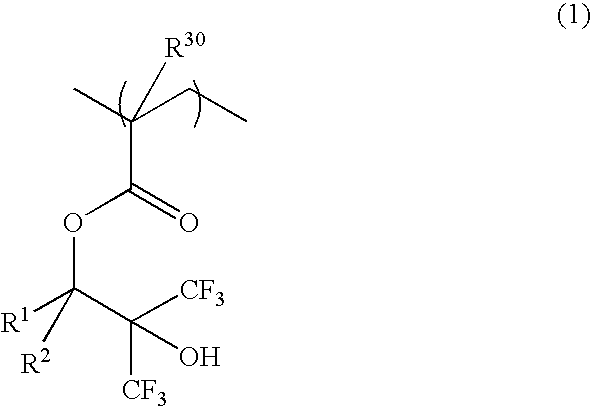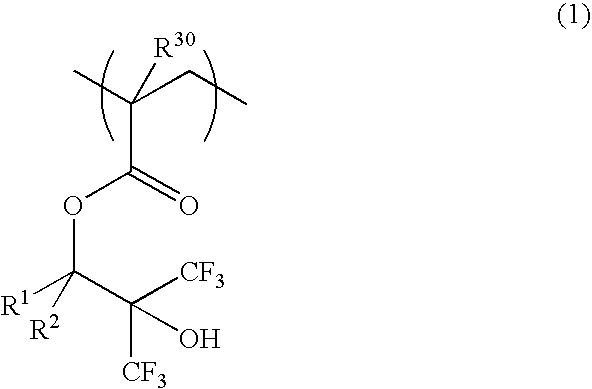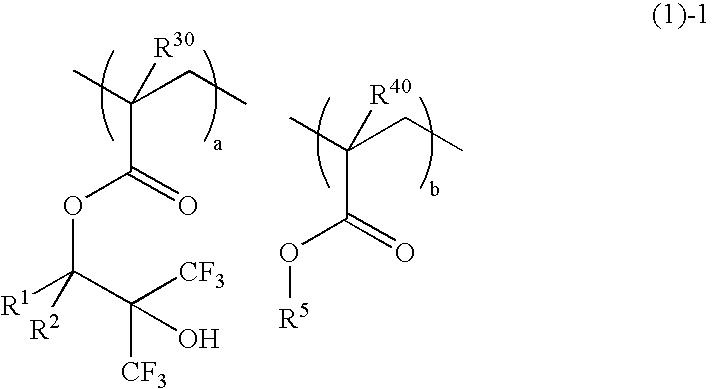Polymer, resist protective coating material, and patterning process
- Summary
- Abstract
- Description
- Claims
- Application Information
AI Technical Summary
Benefits of technology
Problems solved by technology
Method used
Image
Examples
synthesis example 1
[0066]A 200-ml flask was charged with 29 g of Monomer 1 and 40 g of methanol as a solvent. The reactor was cooled to −70° C. in a nitrogen atmosphere, followed by three cycles of vacuum evacuation and nitrogen flow. The reactor was warmed up to room temperature, charged with 3 g of 2,2′-azobis(2,4-dimethylvaleronitrile) as a polymerization initiator, heated at 65° C., and held for 25 hours for reaction. The reaction solution was poured into hexane for crystallization whereupon the resin was isolated. The resin, designated Inventive Polymer 1, was analyzed for composition by 1H-NMR and for molecular weight by GPC.
synthesis example 2
[0067]A 200-ml flask was charged with 32 g of Monomer 2 and 40 g of methanol as a solvent. The reactor was cooled to −70° C. in a nitrogen atmosphere, followed by three cycles of vacuum evacuation and nitrogen flow. The reactor was warmed up to room temperature, charged with 3 g of 2,2′-azobis(2,4-dimethylvaleronitrile) as a polymerization initiator, heated at 65° C., and held for 25 hours for reaction. The reaction solution was poured into hexane for crystallization whereupon the resin was isolated. The resin, designated Inventive Polymer 2, was analyzed for composition by 1H-NMR and for molecular weight by GPC.
synthesis example 3
[0068]A 200-ml flask was charged with 20.3 g of Monomer 1, 4.5 g of Monomer 3, 2.3 g of Monomer 4, and 40 g of methanol as a solvent. The reactor was cooled to −70° C. in a nitrogen atmosphere, followed by three cycles of vacuum evacuation and nitrogen flow. The reactor was warmed up to room temperature, charged with 3 g of 2,2′-azobis(2,4-dimethylvaleronitrile) as a polymerization initiator, heated at 65° C., and held for 25 hours for reaction. The reaction solution was poured into hexane for crystallization whereupon the resin was isolated. The resin, designated Inventive Polymer 3, was analyzed for composition by 1H-NMR and for molecular weight by GPC.
PUM
| Property | Measurement | Unit |
|---|---|---|
| Percent by mass | aaaaa | aaaaa |
| Wavelength | aaaaa | aaaaa |
| Fraction | aaaaa | aaaaa |
Abstract
Description
Claims
Application Information
 Login to View More
Login to View More - R&D
- Intellectual Property
- Life Sciences
- Materials
- Tech Scout
- Unparalleled Data Quality
- Higher Quality Content
- 60% Fewer Hallucinations
Browse by: Latest US Patents, China's latest patents, Technical Efficacy Thesaurus, Application Domain, Technology Topic, Popular Technical Reports.
© 2025 PatSnap. All rights reserved.Legal|Privacy policy|Modern Slavery Act Transparency Statement|Sitemap|About US| Contact US: help@patsnap.com



